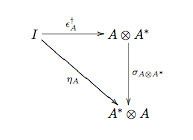 | ||
In mathematics, dagger compact categories (or dagger compact closed categories) first appeared in 1989 in the work of Doplicher and Roberts on the reconstruction of compact topological groups from their category of finite-dimensional continuous unitary representations (that is, Tannakian categories). They also appeared in the work of Baez and Dolan as an instance of semistrict k-tuply monoidal n-categories, which describe general topological quantum field theories, for n = 1 and k = 3. They are a fundamental structure in Abramsky and Coecke's categorical quantum mechanics.
Contents
Overview
Dagger compact categories can be used to express and verify some fundamental quantum information protocols, namely: teleportation, logic gate teleportation and entanglement swapping, and standard notions such as unitarity, inner-product, trace, Choi-Jamiolkowsky duality, complete positivity, Bell states and many other notions are captured by the language of dagger compact categories. All this follows from the completeness theorem, below. Categorical quantum mechanics takes dagger compact categories as a background structure relative to which other quantum mechanical notions like quantum observables and complementarity thereof can be abstractly defined. This forms the basis for a high-level approach to quantum information processing.
Formal definition
A dagger compact category is a dagger symmetric monoidal category
To summarize all of these points:
A dagger compact category is then a category that is each of the above, and, in addition, has a condition to relate the dagger structure to the compact structure. This is done by relating the unit to the counit via the dagger:
shown in the commuting diagram above. In the category FdHilb of finite-dimensional Hilbert spaces, this last condition can be understood as defining the dagger (the Hermitian conjugate) as the transpose of the complex conjugate.
Examples
The following categories are dagger compact.
Infinite-dimensional Hilbert spaces are not dagger compact, and are described by dagger symmetric monoidal categories.
Structural theorems
Selinger showed that dagger compact categories admit a Joyal-Street style diagrammatic language and proved that dagger compact categories are complete with respect to finite dimensional Hilbert spaces i.e. an equational statement in the language of dagger compact categories holds if and only if it can be derived in the concrete category of finite dimensional Hilbert spaces and linear maps. There is no analogous completeness for Rel or nCob.
This completeness result implies that various theorems from Hilbert spaces extend to this category. For example, the no-cloning theorem implies that there is no universal cloning morphism. Completeness also implies far more mundane features as well: dagger compact categories can be given a basis in the same way that a Hilbert space can have a basis. Operators can be decomposed in the basis; operators can have eigenvectors, etc.. This is reviewed in the next section.
Basis
The completeness theorem implies that basic notions from Hilbert spaces carry over to any dagger compact category. The typical language employed, however, changes. The notion of a basis is given in terms of a coalgebra. Given an object A from a dagger compact category, a basis is a comonoid object
Comultiplicativity:
Coassociativity:
Cocommutativity:
Isometry:
To see that these relations define a basis of a vector space in the traditional sense, write the comultiplication and counit using bra–ket notation, and understanding that these are now linear operators acting on vectors
and
The only vectors
General results
Given the above definition of a basis, a number of results for Hilbert spaces can be stated for compact dagger categories. We list some of these below, taken from unless otherwise noted.
